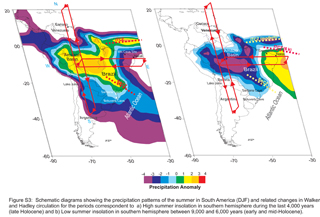- Home
- /
- Google News Feed XML
- /
- Release
- /
UAlbany Scientists Study Past Climate Variability and its Effect on Monsoons in South America
Contact(s): Catherine Herman (518) 956-8150
 |
According to the new study, when monsoons to the south of the equator were weak and conditions dry, not only were the northern monsoons strong and carrying abundant rainfall, but regions adjacent to the southern monsoons were also affected by heavy rainfall. |
ALBANY, N.Y. (February 23, 2009) -- University at Albany Assistant Professor Mathias Vuille, and Postdoctoral Fellow Hanh Nguyen, Department of Earth and Atmospheric Sciences, have collaborated on a new study that reveals monsoons in South America were more far-reaching than previously thought. The study indicates that when monsoons to the south of the equator were weak and conditions dry, not only were the northern monsoons strong and carrying abundant rainfall, but regions adjacent to the southern monsoons were also affected by heavy rainfall.
Researchers have known for years that when monsoons north of the equator (India and Asia) were strong, monsoons south of the equator (Australia and South America) were weak and drought conditions prevailed. However, researchers had not been aware that regions surrounding the monsoons were equally affected.
The study, published in the March issue of Nature Geoscience, was a collaboration among researchers at the University at Albany; University of Massachusetts at Amherst; Universidade de Sao Paulo, Brazil; University of Minnesota; the Alfred Wegener Institute for Polar and Marine Research, Germany; and the Instituto do Carste, Brazil.
 |
Researchers used two approaches to reproduce past climate variability in South America: speleothem analysis, providing the spatial and temporal changes in climate in South America, and model simulations, indicating how the climate system works. |
"Studying monsoon climates is extremely important because so many people live in those regions and depend on it for agriculture, drinking water and sanitation," said Vuille. "Our climate observations in these regions do not go back very far, so it�s important to attempt putting current climatic and environmental conditions in a longer temporal perspective."
Researchers used two approaches to reproduce past climate variability in South America: speleothem analysis, providing the spatial and temporal changes in climate in South America, and model simulations, indicating how the climate system works. The innovative use of both approaches allowed researchers to use data from the speleothem analysis to test the models� ability to accurately reproduce past climate variability in South America.
"Projections of how climate will change in the next 100 years or so due to global warming rely almost exclusively on the exact same type of model we used," said Vuille. "It is therefore very important to test these models and make sure they can accurately simulate past climates."
![]() For more news, subscribe to UAlbany's RSS headline feeds
For more news, subscribe to UAlbany's RSS headline feeds
Educationally and culturally, the University at Albany-SUNY puts "The World Within Reach" for its 18,000 students. An internationally recognized research university with 58 undergraduate majors and 128 graduate degree programs, UAlbany is a leader among all New York State colleges and universities in such diverse fields as public policy, nanotechnology and criminal justice. With a curriculum enhanced by 300 study-abroad opportunities, UAlbany launches great careers. For more information about this globally ranked University, visit www.albany.edu. For UAlbany's extensive roster of faculty experts, visit www.albany.edu/news/experts.shtml.


